Balbharti 12th Maharashtra State Board Maths Solutions Book Pdf Chapter 6 Differential Equations Ex 6.3 Questions and Answers.
12th Maths Part 2 Differential Equations Exercise 6.3 Questions And Answers Maharashtra Board
Question 1.
In each of the following examples verify that the given expression is a solution of the corresponding differential equation.
(i) xy = log y + c; dydx=y21−xy
Solution:
xy = log y + c
Differentiating w.r.t. x, we get
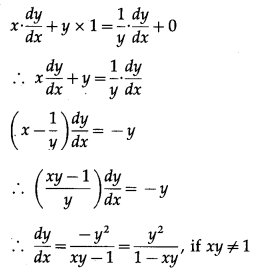
Hence, xy = log y + c is a solution of the D.E.
dydx=y21−xy′,xy≠1
(ii) y = (sin
-1
x)
2
+ c; (1 – x
2
) d2ydx2−xdydx=2
Solution:
y = (sin
-1
x)
2
+ c …….(1)
Differentiating w.r.t. x, we get
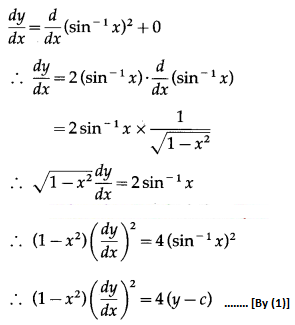
Differentiating again w.r.t. x, we get
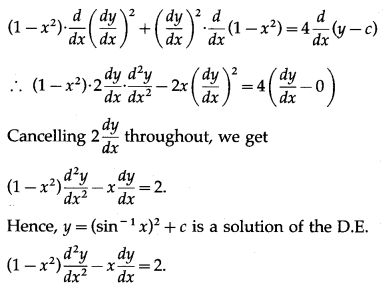

(iii) y = e
-x
+ Ax + B; exd2ydx2=1
Solution:
y = e
-x
+ Ax + B
Differentiating w.r.t. x, we get
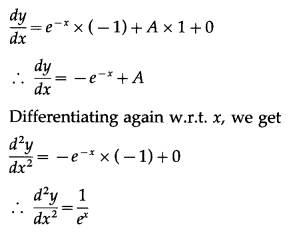
∴ exd2ydx2=1
Hence, y = e
-x
+ Ax + B is a solution of the D.E.
exd2ydx2=1
(iv) y = x
m
; x2d2ydx2−mxdydx+my=0
Solution:
y = x
m
Differentiating twice w.r.t. x, we get
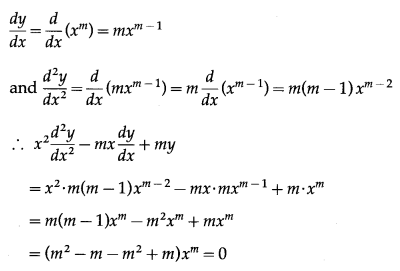
This shows that y = x
m
is a solution of the D.E.
x2d2ydx2−mxdydx+my=0
(v) y = a + bx; xd2ydx2+2dydx=0
Solution:
y = a + bx
Differentiating w.r.t. x, we get
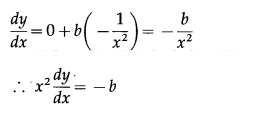
Differentiating again w.r.t. x, we get
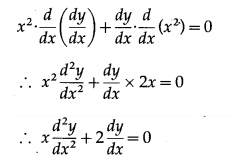
Hence, y = a + bx is a solution of the D.E.
xd2ydx2+2dydx=0

(vi) y = e
ax
; x dydx = y log y
Solution:
y = e
ax
log y = log e
ax
= ax log e
log y = ax …….(1) ……..[∵ log e = 1]
Differentiating w.r.t. x, we get
1y⋅dydx = a × 1
∴ dydx = ay
∴ x dydx = (ax)y
∴ x dydx = y log y ………[By (1)]
Hence, y = e
ax
is a solution of the D.E.
x dydx = y log y.
Question 2.
Solve the following differential equations.
(i) dydx=1+y21+x2
Solution:
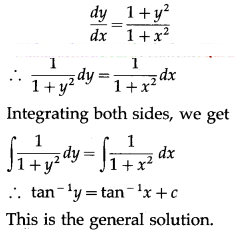
(ii) log(dydx) = 2x + 3y
Solution:
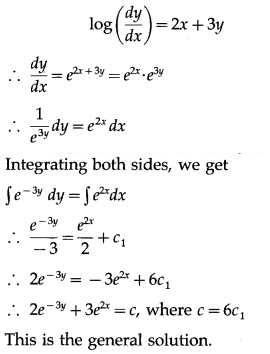
(iii) y – x dydx = 0
Solution:
y – x dydx = 0
∴ x dydx = y
∴ 1xdx=1ydy
Integrating both sides, we get
∫1xdx=∫1ydy
∴ log |x| = log |y| + log c
∴ log |x| = log |cy|
∴ x = cy
This is the general solution.

(iv) sec
2
x . tan y dx + sec
2
y . tan x dy = 0
Solution:
sec
2
x . tan y dx + sec
2
y . tan x dy = 0
∴ sec2xtanxdx+sec2ytanydy=0
Integrating both sides, we get
∫sec2xtanxdx+∫sec2ytanydy=c1
Each of these integrals is of the type
∫f′(x)f(x)dx = log |f(x)| + c
∴ the general solution is
∴ log|tan x| + log|tan y | = log c, where c
1
= log c
∴ log |tan x . tan y| = log c
∴ tan x . tan y = c
This is the general solution.
(v) cos x . cos y dy – sin x . sin y dx = 0
Solution:
cos x . cos y dy – sin x . sin y dx = 0
cosysinydy−sinxcosxdx=0
Integrating both sides, we get
∫cot y dy – ∫tan x dx = c
1
∴ log|sin y| – [-log|cos x|] = log c, where c
1
= log c
∴ log |sin y| + log|cos x| = log c
∴ log|sin y . cos x| = log c
∴ sin y . cos x = c
This is the general solution.
(vi) dydx = -k, where k is a constant.
Solution:
dydx = -k
∴ dy = -k dx
Integrating both sides, we get
∫dy = -k∫dx
∴ y = -kx + c
This is the general solution.

(vii) cos2yxdy+cos2xydx=0
Solution:
cos2yxdy+cos2xydx=0
∴ y cos
2
y dy + x cos
2
x dx = 0
∴ x(1+cos2x2)dx+y(1+cos2y2)dy=0
∴ x(1 + cos 2x) dx + y(1 + cos 2y) dy = 0
∴ x dx + x cos 2x dx + y dy+ y cos 2y dy = 0
Integrating both sides, we get
∫x dx + ∫y dy + ∫x cos 2x dx + ∫y cos 2y dy = c
1
……..(1)
Using integration by parts
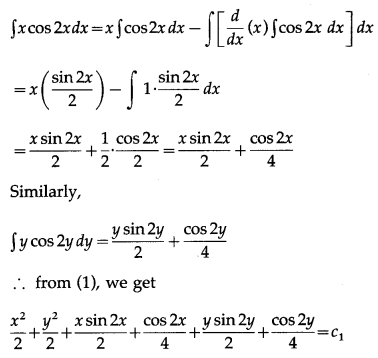
Multiplying throughout by 4, this becomes
2x
2
+ 2y
2
+ 2x sin 2x + cos 2x + 2y sin 2y + cos 2y = 4c
1
∴ 2(x
2
+ y
2
) + 2(x sin 2x + y sin 2y) + cos 2y + cos 2x + c = 0, where c = -4c
1
This is the general solution.
(viii) y3−dydx=x2dydx
Solution:
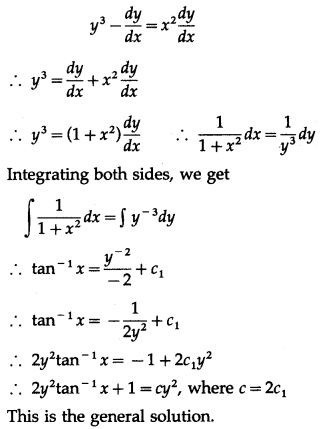
(ix) 2e
x+2y
dx – 3 dy = 0
Solution:
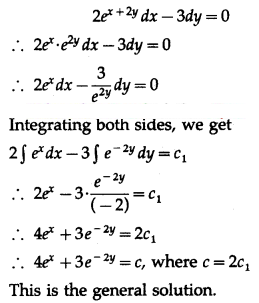

(x) dydx = e
x+y
+ x
2
e
y
Solution:
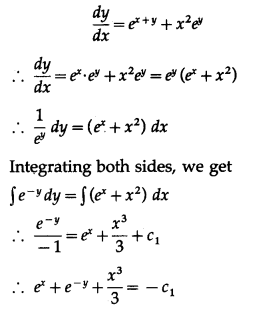
∴ 3e
x
+ 3e
-y
+ x
3
= -3c
1
∴ 3e
x
+ 3e
-y
+ x
3
= c, where c = -3c
1
This is the general solution.
Question 3.
For each of the following differential equations, find the particular solution satisfying the given condition:
(i) 3e
x
tan y dx + (1 + e
x
) sec
2
y dy = 0, when x = 0, y = π
Solution:
3e
x
tan y dx + (1 + e
x
) sec
2
y dy = 0
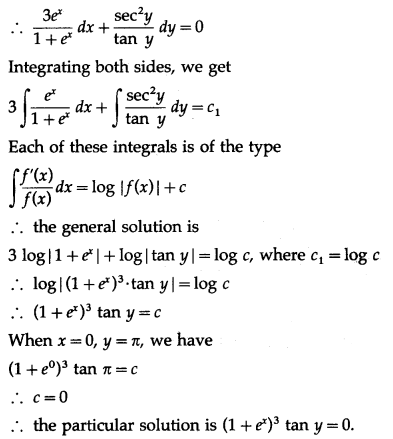
(ii) (x – y
2
x) dx – (y + x
2
y) dy = 0, when x = 2, y = 0
Solution:
(x – y
2
x) dx – (y + x
2
y) dy = 0
∴ x(1 – y
2
) dx – y(1 + x
2
) dy = 0
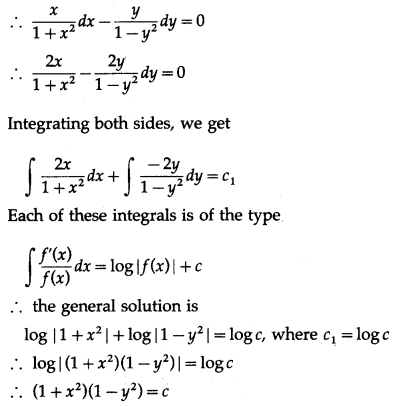
When x = 2, y = 0, we have
(1 + 4)(1 – 0) = c
∴ c = 5
∴ the particular solution is (1 + x
2
)(1 – y
2
) = 5.
(iii) y(1 + log x) dxdy – x log x = 0, y = e
2
, when x = e
Solution:
y(1 + log x) dxdy – x log x = 0
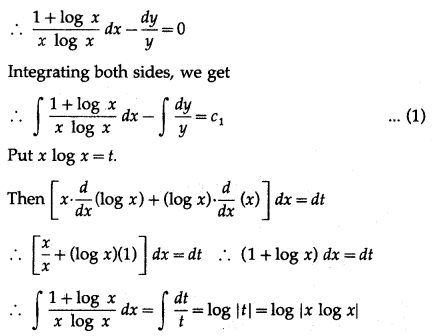
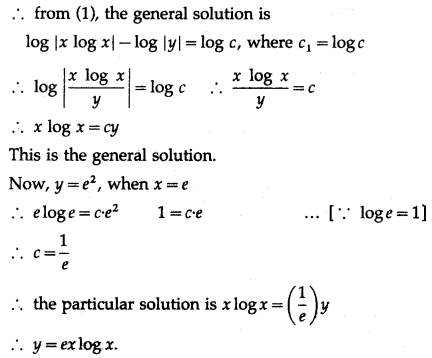

(iv) (e
y
+ 1) cos x + e
y
sin x dydx = 0, when x = π6, y = 0
Solution:
(e
y
+ 1) cos x + e
y
sin x dydx = 0
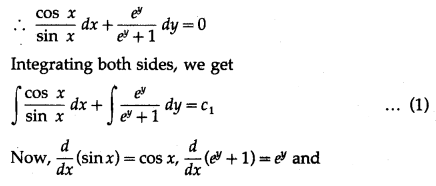
∫f′(x)f(x)dx = log|f(x)| + c
∴ from (1), the general solution is
log|sin x| + log|e
y
+ 1| = log c, where c
1
= log c
∴ log|sin x . (e
y
+ 1)| = log c
∴ sin x . (e
y
+ 1) = c
When x = π4, y = 0, we get
(sinπ4)(e0+1)=c
∴ c = 1√2(1 + 1) = √2
∴ the particular solution is sin x . (e
y
+ 1) = √2
(v) (x + 1) dydx – 1 = 2e
-y
, y = 0, when x = 1
Solution:
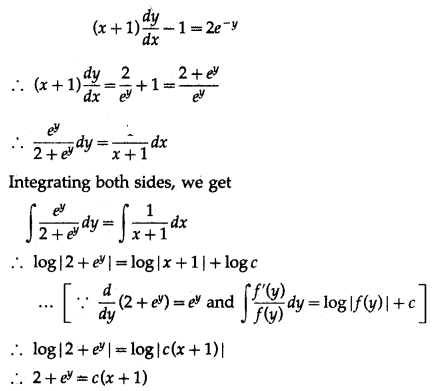
This is the general solution.
Now, y = 0, when x = 1
∴ 2 + e
0
= c(1 + 1)
∴ 3 = 2c
∴ c = 32
∴ the particular solution is 2 + e
y
= 32 (x + 1)
∴ 2(2 + e
y
) = 3(x + 1).

(vi) cos(dydx) = a, a ∈ R, y (0) = 2
Solution:
cos(dydx) = a
∴ dydx = cos
-1
a
∴ dy = (cos
-1
a) dx
Integrating both sides, we get
∫dy = (cos
-1
a) ∫dx
∴ y = (cos
-1
a) x + c
∴ y = x cos
-1
a + c
This is the general solution.
Now, y(0) = 2, i.e. y = 2,
when x = 0, 2 = 0 + c
∴ c = 2
∴ the particular solution is
∴ y = x cos
-1
a + 2
∴ y – 2 = x cos
-1
a
∴ y−2x = cos
-1
a
∴ cos(y−2x) = a
Question 4.
Reduce each of the following differential equations to the variable separable form and hence solve:
(i) dydx = cos(x + y)
Solution:
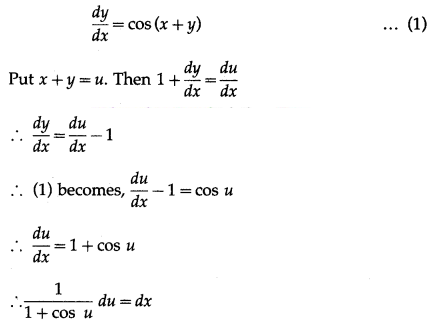
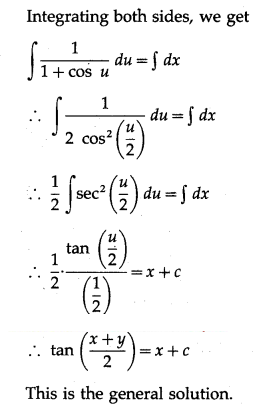

(ii) (x – y)
2
dydx = a
2
Solution:
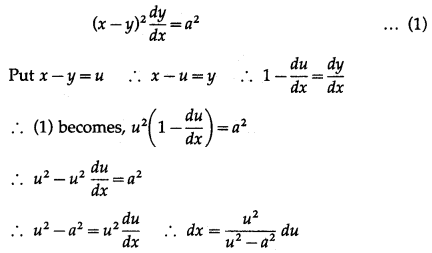
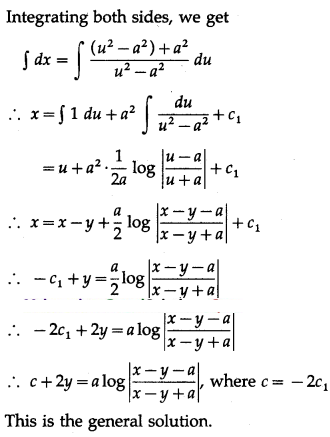
(iii) x + y dydx = sec(x
2
+ y
2
)
Solution:
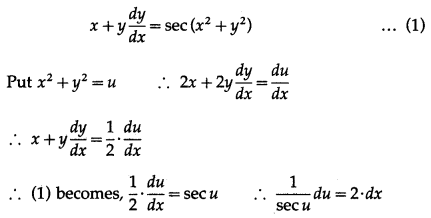
Integrating both sides, we get
∫cos u du = 2 ∫dx
∴ sin u = 2x + c
∴ sin(x
2
+ y
2
) = 2x + c
This is the general solution.
(iv) cos
2
(x – 2y) = 1 – 2 dydx
Solution:
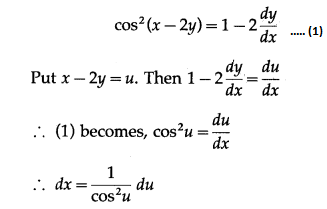
Integrating both sides, we get
∫dx = ∫sec
2
u du
∴ x = tan u + c
∴ x = tan(x – 2y) + c
This is the general solution.

(v) (2x – 2y + 3) dx – (x – y + 1) dy = 0, when x = 0, y = 1
Solution:
(2x – 2y + 3) dx – (x – y + 1) dy = 0
∴ (x – y + 1) dy = (2x – 2y + 3) dx
∴ dydx=2(x−y)+3(x−y)+1 ………(1)
Put x – y = u, Then 1−dydx=dudx
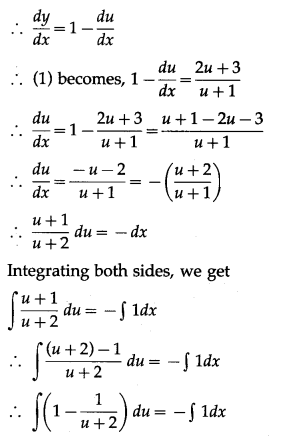
∴ u – log|u + 2| = -x + c
∴ x – y – log|x – y + 2| = -x + c
∴ (2x – y) – log|x – y + 2| = c
This is the general solution.
Now, y = 1, when x = 0.
∴ (0 – 1) – log|0 – 1 + 2| = c
∴ -1 – o = c
∴ c = -1
∴ the particular solution is
(2x – y) – log|x – y + 2| = -1
∴ (2x – y) – log|x – y + 2| + 1 = 0